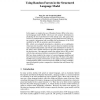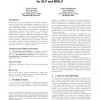853 search results - page 27 / 171 » Combining Data and Mathematical Models of Language Change |
FIW
2009
13 years 5 months ago
2009
One of the most difficult tasks in software development is that features are implemented by changing the code of other features. This problem cannot be solved with existing general...
ICMCS
2007
IEEE
14 years 1 months ago
2007
IEEE
We present a novel genre-independent SVM framework for detecting scene changes in broadcast video. Our framework works on content from a diverse range of genres by allowing sets o...
BMCBI
2005
13 years 7 months ago
2005
Background: Functional analysis of data from genome-scale experiments, such as microarrays, requires an extensive selection of differentially expressed genes. Under many condition...
NIPS
2004
13 years 8 months ago
2004
In this paper, we explore the use of Random Forests (RFs) in the structured language model (SLM), which uses rich syntactic information in predicting the next word based on words ...
GECCO
2007
Springer
14 years 1 months ago
2007
Springer
Engineering design increasingly uses computer simulation models coupled with optimization algorithms to find the best design that meets the customer constraints within a time con...


